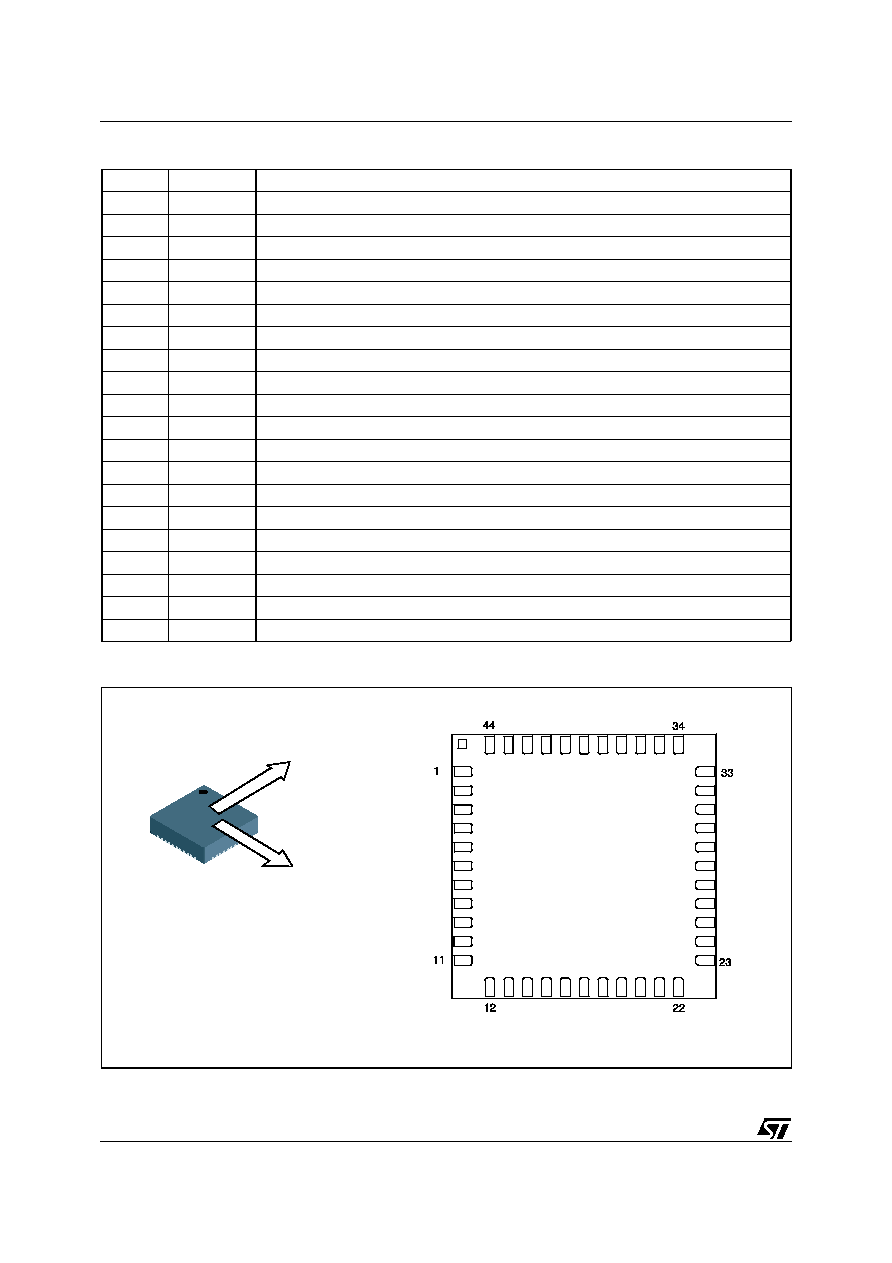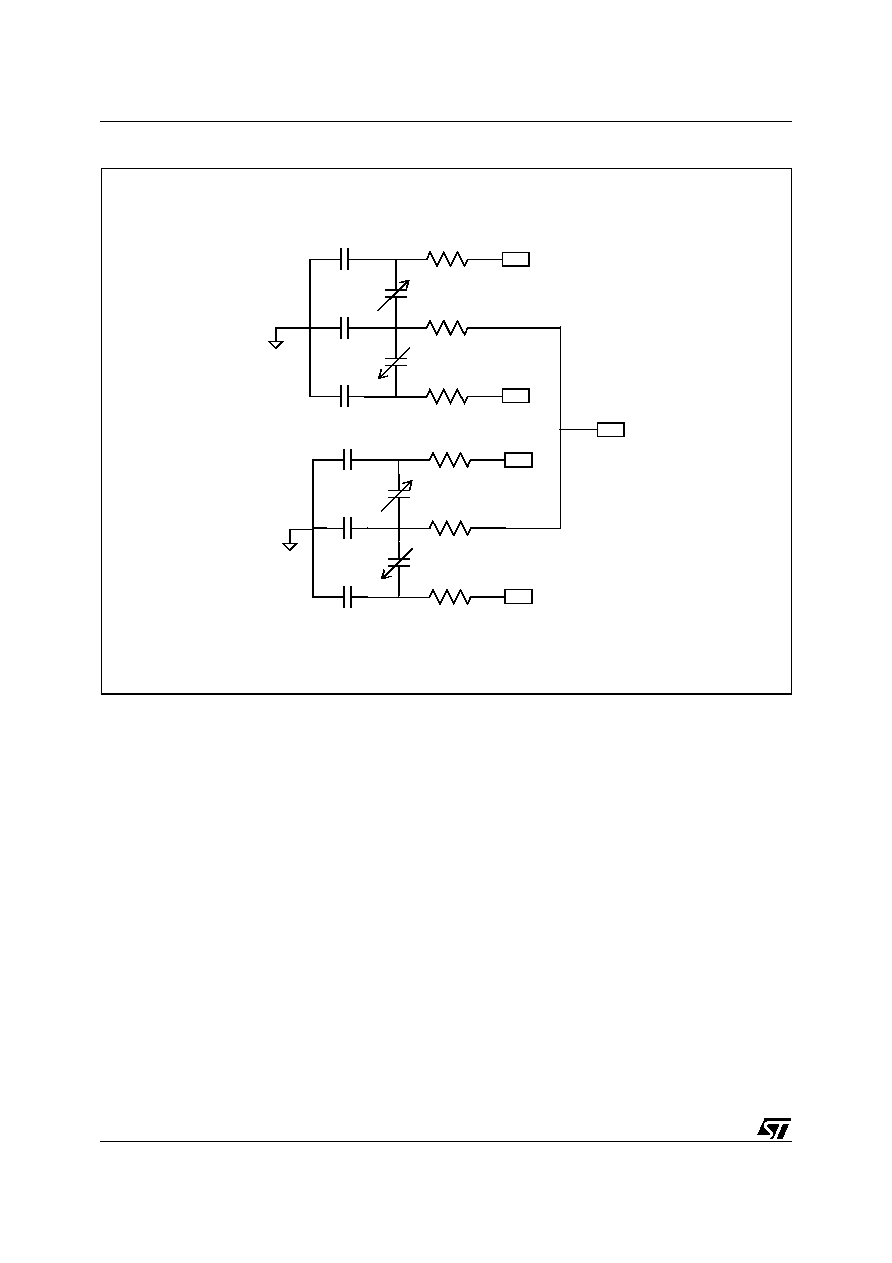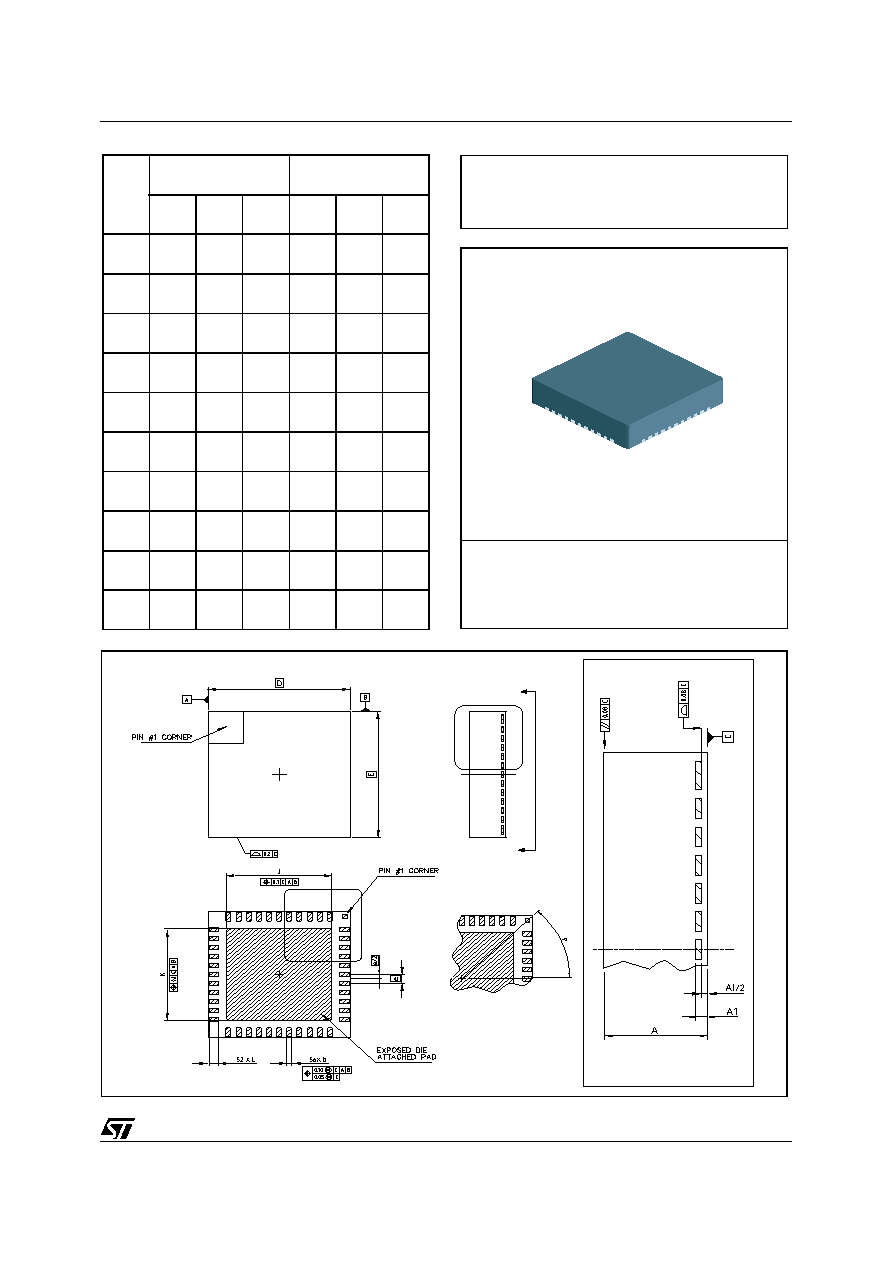 | –≠–ª–µ–∫—Ç—Ä–æ–Ω–Ω—ã–π –∫–æ–º–ø–æ–Ω–µ–Ω—Ç: LIS2L02AQ | –°–∫–∞—á–∞—Ç—å:  PDF PDF  ZIP ZIP |

1/6
LIS2L02AQ
December 2002
This is preliminary information on a new product now in development. Details are subject to change without notice.
s
3V TO 5.25V SINGLE SUPPLY OPERATION
s
THE SENSITIVITY IS ADJUSTED WITH A
TOTAL ACCURACY OF ±10%
s
THE OUTPUT VOLTAGE, OFFSET,
SENSITIVITY AND TEST VOLTAGE ARE
RATIOMETRIC TO THE SUPPLY VOLTAGE
s
DEVICE SENSITIVITY IS ON-CHIP FACTORY
TRIMMED
s
EMBEDDED SELF TEST
s
HIGH SHOCK SURVIVABILITY
DESCRIPTION
The LIS2L02AQ is a dual-axis linear accelerometer
that includes a sensing element and an IC interface
able to take the information from the sensing element
and to provide an analog signal to the external world.
The sensing element, capable to detect the acceler-
ation, is manufactured using a dedicated process
called THELMA (Thick Epi-Poly Layer for Microactu-
ators and Accelerometers) developed by ST to pro-
duce inertial sensors and actuators in silicon.
The IC interface instead is manufactured using a
CMOS process that allows high level of integration to
design a dedicated circuit which is trimmed to better
match the sensing element characteristics.
The LIS2L02AQ has a user selectable full scale of
2g, 6g and it is capable of measuring accelerations
over a maximum bandwidth of 4.0 KHz for both the X
and Y axis. The device bandwidth may be reduced by
using external capacitances. A self-test capability al-
lows the user to check the functioning of the system.
The LIS2L02AQ is available in plastic SMD package
and it is specified over a temperature range extend-
ing from -40∞C to +85∞C.
The LIS2L02AQ belongs to a family of products suit-
able for a variety of applications:
≠ Antitheft systems
≠ Inertial navigation
≠ Virtual reality input devices
≠ Vibration Monitoring, recording and compen-
sation
≠ Appliance control
≠ Robotics
QFN-44
ORDERING NUMBER: LIS2L02AQ
PRODUCT PREVIEW
INERTIAL SENSOR:
2Axis - 2g/6g LINEAR ACCELEROMETER
BLOCK DIAGRAM
DEMUX
S/H
CHARGE
AMPLIFIER
S/H
MUX
S1X
S1Y
S2X
S2Y
Voutx
Vouty
Routx
Routy
rot
VOLTAGE & CURRENT
REFERENCE
TRIMMING CIRCUIT
&
CLOCK
&
PHASE GENERATOR
TEST INTERFACE

LIS2L02AQ
2/6
PIN DESCRIPTION
PIN CONNECTION (Top view)
N∞
Pin
Function
1 to 3
NC
Internally not connected
4
GND
0V supply
5
Vdd
Power supply
6
Vouty
Output Voltage
7
ST
Self Test (Logic 0: normal mode; Logic 1: Self-test)
8
Voutx
Output Voltage
9-13
NC
Internally not connected
14
PD
Power Down (Logic 0: normal mode; Logic 1: Power-Down mode)
15
NC
Internally not connected
16
FS
Full Scale selection (Logic 0: 2g Full-scale; Logic 1: 6g Full-scale)
17-18
Reserved
Leave unconnected
19
NC
Internally not connected
20
Reserved
Leave unconnected
21
NC
Internally not connected
22-23
Reserved
Leave unconnected
24-25
NC
Internally not connected
26
Reserved
Connect to Vdd or GND
27
Reserved
Leave unconnected or connect to Vdd
28
Reserved
Leave unconnected or connect to GND
29-44
NC
Internally not connected
DIRECTION OF THE
DETECTABLE
ACCELERATIONS
Y
1
X
NC
NC
NC
GND
Vdd
Vouty
ST
Voutx
NC
NC
NC
NC
NC
NC
NC
NC
Reserved
Reserved
Reserved
NC
NC
Reserved
NC
NC
PD
NC
FS
Res
er
v
e
d
Res
er
v
e
d
Res
er
v
e
d
Res
er
v
e
d
NC
Res
er
v
e
d
NC
NC
NC
NC
NC
NC
NC
NC
NC
NC
NC
LIS2L02AQ

3/6
LIS2L02AQ
ELECTRICAL CHARACTERISTCS (Temperature range -40∞C to +85∞C)
1
FUNCTIONALITY
1.1 Sensing element
The THELMA process is utilized to create a surface micro-machined accelerometer. The technology allows to
carry out suspended silicon structures which are attached to the substrate in a few points called anchors and
free to move on a plane parallel to the substrate itself. To be compatible with the traditional packaging tech-
niques a cap is placed on top of the sensing element to avoid blocking the moving parts during the molding
phase.
The equivalent circuit for the sensing element is shown in the below figure; when a linear acceleration is applied,
the proof mass displaces from its nominal position, causing an imbalance in the capacitive half-bridge. This im-
balance is measured using charge integration in response to a voltage pulse applied to the sense capacitor.
The nominal value of the capacitors, at steady state, is few pF and when an acceleration is applied the maximum
variation of the capacitive load is few tenth of pF.
Symbol
Parameter
Test Condition
Min.
Typ.
Max.
Unit
V
dd
Supply voltage
3
5.25
V
I
dd
Supply current
1.0
mA
V
off
Zero-g level
T
amb
= 25∞C
ratiometric to Vdd
V
dd
/2-10%
V
dd
/2
V
dd
/2+10%
V
A
r
Acceleration range
0V on FS pin
±
1.8
±
2.0
±
2.2
g
V
dd
on FS pin
±
6.0
g
S
o
Sensitivity ratiometric to
V
dd
T
amb
= 25∞C
Full-scale = 2g
V
dd
/5≠10%
V
dd
/5
V
dd
/5+10%
V/g
T
amb
= 25∞C
Full-scale = 6g
V
dd
/15≠10%
V
dd
/15
V
dd
/15+10%
V/g
N
L
Non Linearity
Best fit straight line
X, Y axis
Full-scale = 2g
±
0.3
%
f
uc
Sensing Element
Resonant Frequency
X, Y axis
4.0
KHz
a
n
Acceleration noise
density
V
dd
= 5V
Full-scale = 2g
50
µ
g/
V
t
Self test output voltage
Ratiometric to Vdd
T
amb
= 25∞C
@ 5V
100
mV
V
st
Self test input
Logic 0 level
0
0.8
V
Logic 1 level
2.8
V
dd
V
R
out
Output impedance
100
k
C
load
Capacitive load drive
320
pF
Hz

LIS2L02AQ
4/6
Figure 1. Equivalent electrical circuit
1.2 IC Interface
The complete signal processing uses a fully differential structure, while the final stage converts the differential
signal into a single-ended one to be compatible with the external world.
The first stage is a low-noise capacitive amplifier that implements a Correlated Double Sampling (CDS) at its
output to cancel the offset and the 1/f noise. The produced signal is then sent to two different S&Hs, one for
each channel, and made available to the outside.
The low noise input amplifier operates at 200 kHz while the two S&Hs operate at a sampling frequency of 66
kHz. This allows a large oversampling ratio, which leads to in-band noise reduction and to an accurate output
waveform.
All the analog parameters (output offset voltage and sensitivity) are ratiometric to the voltage supply. Increasing
or decreasing the voltage supply, the sensitivity and the offset will increase or decrease linearly. The feature
provides the cancellation of the error related to the voltage supply along an analog to digital conversion chain.
1.3 Factory calibration
The IC interface is factory calibrated to provide to the final user a device ready to operate. The parameters which
are trimmed are: gain, offset, common mode and internal clock frequency.
The trimming values are stored inside the device by a poly-fuse structure. Any time the device is turned on, the
memorized bits are downloaded into the registers to be employed during the normal operation. The poly-fuse
approach allows the final user to utilize the device without any need for further calibration
C
s1x
C
s2x
C
ps1
C
ps2
C
pr
R
s2
R
s1
R
r
S1x
rot
S2x
C
s1y
C
s2y
C
ps1
C
ps2
C
pr
R
s2
R
s1
R
r
S1y
S2y

5/6
LIS2L02AQ
OUTLINE AND
MECHANICAL DATA
DIM.
mm
inch
MIN.
TYP.
MAX.
MIN.
TYP.
MAX.
A
1.70
1.80
1.90
0.067
0.071
0.075
A1
0.19
0.21
0.007
0.008
b
0.20
0.25
0.30
0.008
0.01
0.012
D
7.0
0.276
E
7.0
0.276
e
0.50
0.020
J
5.04
5.24
0.198
0.206
K
5.04
5.24
0.198
0.206
L
0.38
0.48
0.58
0.015
0.019
0.023
P
45 REF
45 REF
QFN-44 (7x7x1.8mm)
Quad Flat Package No lead
G
M
M
DETAIL "N"
34
44
11
1
N
22
12
23
33
44
1
DETAIL G
SEATING PLANE




